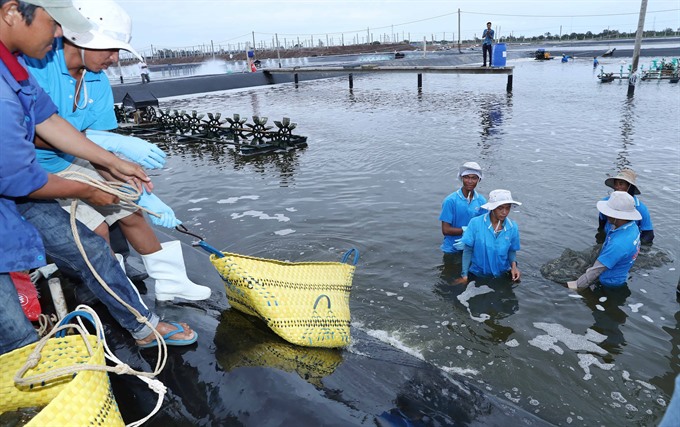 Society
Society

The restructuring of agricultural production in the Mekong Delta province of Sóc Trăng has helped farmers adapt to climate change, produce hi-tech products, and earn higher incomes.
 |
| A shirmp farm model at Khánh Sủng Ltd Company in southern province of Sóc Trăng.Sóc Trăng has more than 65,000ha of aquaculture area, including 50,000ha of brackish water shrimp. — VNA/VNS Photo Thống Nhất |
HCM CITY – The restructuring of agricultural production in the Mekong Delta province of Sóc Trăng has helped farmers adapt to climate change, produce hi-tech products, and earn higher incomes.
In Cù Lao Dung District, an islet district with the largest sugarcane area in the province, many sugarcane farmers have switched to growing higher-value fruit and breeding aquatic species.
Trần Văn Phục, who turned his 3ha sugarcane field into a longan orchard, said his Ido longan orchard was ready for the first harvest.
As a member of the An Phú Hưng Co-operative, Phục has learned how to plant “clean” longan by using automated irrigation equipment and other methods.
Ido longan is in high demand as supply cannot meet export demand.
Lê Minh Đương, deputy chairman of the Cù Lao Dung District People’s Committee, said: “Saltwater intrusion has not affected sugarcane fields this year, but inclement weather lowered the yield of sugarcane and vegetables.”
The district plans to turn 1,000ha of sugarcane into cultivation areas for fruit trees like longan and coconut, and for the breeding of aquatic species this year.
Under the province’s agricultural restructuring plan for the 2014-20 period, only two, not three, rice crops are now grown each year in Long Phú and Trần Đề districts.
In addition, one cash crop is cultivated each year in Long Phú and Trần Đề, as well as one rice crop and one shrimp crop a year in saltwater-affected areas in Mỹ Xuyên District.
The restructuring of agricultural production in the province suits the local weather and natural conditions, according to Lương Minh Quyết, director of the province’s Department of Agriculture and Rural Development.
In Mỹ Tú and Thạnh Trị districts, farmers have planted other cash crops in rice fields that lack irrigation water in the dry season, earning higher profits than from rice.
Dương Văn Chiến in Thạnh Trị’s Lâm Khiết Commune said he had planted 2,000sq.m of watermelon during the dry season.
After two months, he harvested the crop and earned a profit of more than VNĐ10 million (US$430) per 1,000sq.m, four to five times higher than that of rice.
The province plans to shift 7,300ha of ineffective rice fields to other crops and aquatic cultivation this year, according to the Department of Agriculture and Rural Development.
It is also focusing on planting high-quality specialty rice and fragrant rice to meet export demand. The specialty and fragrant rice areas cover 177,000ha, accounting for more than 50 per cent of the province’s total rice area.
The province has also developed 530 large-scale rice fields on a total area of 52,000ha.
Aquaculture
Located at the end of the Hậu River, a tributary of the Mekong River, Sóc Trăng Province has a coastline of 72km, a favourable condition for brackish water aquaculture.
In Mỹ Xuyên District, the shrimp-rice farming model that rotates planting fragrant rice and breeding shrimp on the same rice field has been used on tens of thousands of hectares of rice fields. The model does not use chemicals.
Sóc Trăng has more than 65,000ha of aquaculture area, including 50,000ha of brackish water shrimp.
The province has implemented several measures to develop brackish water shrimp, including soft loans and farming techniques, new infrastructure for shrimp farming areas, and application of Vietnamese Good Agricultural Practices (VietGAP) standards to breed shrimp.
It has also encouraged farmers to develop co-operatives to improve productivity and secure outlets for their produces.
The Hòa Nhờ A 14/10 Agriculture and Fisheries Co-operative in Mỹ Xuyên’s Hòa Tú 2 Commune is one of the province’s first co-operatives that have been certified with VietGAP standards for breeding black tiger shrimp and white-legged shrimp.
The co-operative has 20 members who are breeding brackish shrimp on a total of 26.6ha.
Lâm Minh Lớn, a member of the co-operative, said he had bred black tiger shrimp under VietGAP standards for two years. He earned a profit of VNĐ400 million ($17,240) from 2.2ha of black tiger shrimp in the last crop.
Quách Thị Thanh Bình, deputy head of the province’s Sub-department of Fisheries, said the provincial People’s Committee spends about VNĐ400 million a year to encourage farmers to breed shrimp under VietGAP standards.
The province’s agricultural production value reached VNĐ147 million ($6,330) per ha last year, up VNĐ12 million against 2016.
This year the province targets increasing value to VNĐ150 million ($6,460) per ha, according to the provincial Department of Agriculture and Rural Development. – VNS